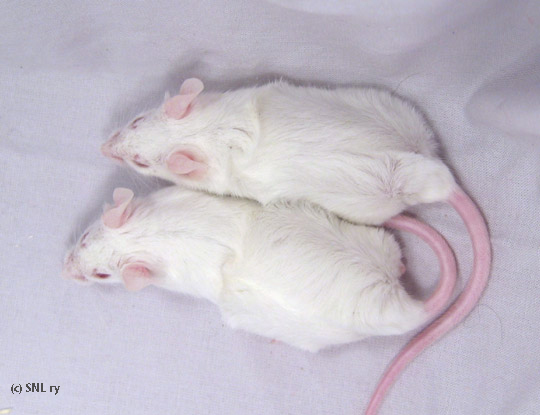Genetics
Coats
Coats
Major Coat Affecting Genes
1. Satin coat, sa
Satin coat is recessive and caused by 'sa'. The variety was introduced to the mouse fancy in 1973 by Tony Cooke and the original mouse was a single buck carrying this gene! Over the years this beautiful shiny coat variety has proved to be very popular. As with any recessive, breeding two satins together will produce only satins and two non-satins can produce satins if both parents carry the gene. There isn't actually that much breeding or work involved with the satin coat.
Satin mice can be bred in any colour, but the satin effect causes the colors to be slightly different than in the short hair varieties. In dark colors the satin effect does not show very well, unlike in the lighter colors. For example in the Black Tan, you may not be able to tell a non-satin and satin apart without looking at the belly.
1.2. Genes with satin-like effects
While satin / sa is "the" mouse fancy satin gene, there does exist other genes with satin-like effects. The availability of the "other satin genes" to the mouse fancy is more than questionable, as is their usefullness. These genes include:
- Satin-like (sal), which is a radiation induced mutation. This gene is recessive, although occasionally a heterozygote (Sal/sal) can be identified from a non-satin-like homozygote (Sal/Sal).
- Skin/coat color 40 (skcm40Jus), a chemically induced recessive, causing abnormal hair keratinization. Also called "satinm1jus".
- Velvet coat (Ve), a radiation induced semidominant. This gene gives "greasy looking" hair, but can't be mistaken for a satin, as the gene also gives the mice an untidy, disheveled look.
- Greasy (Gs), a spontaneous, sex-linked semidominant. Gs gives a shiny fur, but not without problems. In homozyous form (due to being sex-linked, only seen on females), it can cause both polydactyly (extra toes) and syndactyly (fused toes) and tabby-like striped appearance. Gs/Y (males) have oily looking and feeling coat and darker colouring with less yellow pigment than on a non-greasy mouse.
2. The long hair coat, go
The long hair coat variety. Like the satin variety, the long haired originated from a lab (in 1966). This coat variety is also recessive and furthermore, it is highly dependent on modifying genes. This being the case, a breeder may get excellent long haired mice from breeding two short haired mice together. Of course, when you are deliberately trying to breed long hair, the modifiers just don't match and you get "slightly longer than short hair" -coated mice...
Hard work and continuous selective breeding for best coats and good colour & type is the key thing in breeding long hair. Easiest variety by far is the albino, as the breeder can concentrate solely on the coat (well, the most important things of health, longevity, temperament and type are always considered, although I haven't typed it in every single time), not having to work on good colour as well. The coat looks at its best on very young mice.
For further information, read "long hair" in the varieties section.
2.2.Other long coat genes
- long hair (lgh), a spontaneous recessive, chromosome 8. Identifiable from 5 weeks on. Guard hairs are long, but adult mice lack zig zag hairs (underhairs) on body, head and feet have normal coat. Mice also tend to get skin lesions.
- targeted mutation 1, Gail R. Martin (Fgf5tm1Mrt), targeted mutation, chromosome 5. Identifiable from 3 weeks on. Coat stays long, with all hair types 50% longer than on a short hair.
- skin/coat 6 (skc6), chemically induced recessive mutation, chromosome unknown. Gives long hair, but the coat is described as pale.
- skin/coat 8 (skc8), chemically induced recessive mutation, chromosome 15. Gives long hair.
3. The curly coat genes
There are a number of different genes causing the curly coat in mice. They are all dependent on modifying genes and are located in different loci. This makes it possible to combine all three (well, four) genes discussed here into one single mouse, creating the best possible curls in the coat. The whiskers of all curled varieties are curly or at least wavy.
3.1. Astrex, Re
The most common genotype of an Astrex mouse is Re/*. The scientific name of the locus in question is "rex" and the symbol is "Re". This dominant gene is a spontaneous mutation and it is located in chromosome 11. Being dominant, both Re/re and Re/Re produces curly coat. However, homozygous mice show more curl, especially youngsters. The coat gradually straightens with age, while whiskers and guard hairs remain wavy.
3.2. Rex, fz
The Rex mouse is, according to the information I have, what is found in the UK. This recessive gene causes an "afro" -style coat, with rather thin, tightly curled hair. This information is backed up by my sources. The official name for this gene is fuzzy.
3.3. Frizzie, fr
This is what is usually found in the USA, according to the information I have. The gene is recessive and produces very curly coat. This gene should produce rather short and rough looking coat. The official name for this gene is frizzy.
3.4. Caracul, Ca
Caracul is a gene with 16 alleles situated in chromosome 15. The official name of this gene is "keratin 71" and symbol "Krt71". The one allele available within the mouse fancy is "Krt71Ca", caracul. Even though the gene is a semidominant, both homozygous and heterozygous forms look alike.
Alone, without other curly coat genes present, caracul produces poor curls. Young caracul mice have wavy coat and curved whiskers, but the waves begin to straighten already at four weeks of age. Adult caraculs look "plushy". Characteristic feature for caracul is a "kink" at the tip of the hair.
3.5. Some more curlies
- fuzzy (fz), spontaneous recessive, chromosome 1. fz produces thin, but very curly coat, that gets thicker and curlier with each successive moult.
- frizzy (fr), spontaneous recessive, chromosome 7. The coat starts out as short and rough, turning into short and sparse on older mice.
- Caracul-like (cal). Spontaneous dominant, chromosome 15. As the name suggests, the gene acts like caracul; youngsters are curly, but the coat looks almost completely straight by eight weeks of age.
- Caracul-like 2, Caracul-like 7 (Cal2, Cal7). Six genes situated in chromosome 15, all resembling caracul-like in action. Some of these genes produce coats that keep their curls longer than others. Cal7 differs from the rest by lightening the colour of eyes, ears, feet, tail and coat as well.
- crimpy (cpy). Spontaneous recessive, chromosome 15. Homozygotes have wavy, plushy looking coat and wavy whisers. No information on how well the coat keeps was available at the time of writing.
- wooly (wly). Spontaneous recessive, chromosome 11. For a breeder, a quite useless curling gene, which causes mice to have curls (but straight whiskers) around 4 weeks of age, reaching adulthood the coat is straight.
4. Abessinian, rst
rst is a spontaneous mutation originating in British mouse fancy - not a lab. The gene is called rosette (rst) and there's only one mutation known. Chromosome is currently unknown.

|
Ab pew does |
